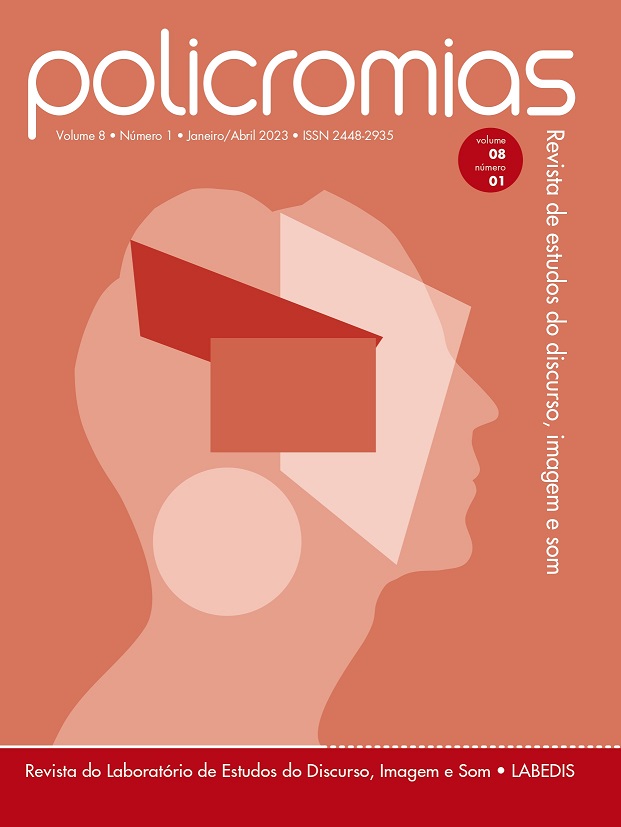A INTERDISCURSIVIDADE ENTRE CIÊNCIA, POLÍTICA E REDES SOCIAIS DURANTE O PRIMEIRO SEMESTRE DA PANDEMIA DE COVID-19
DOI:
https://doi.org/10.61358/policromias.v8i1.56154Palavras-chave:
COVID-19, Pandemia, Discurso, Bakhtin.Resumo
Esse artigo considera como recorte histórico os seis primeiros meses da pandemia de COVID-19. Dentro desse recorte histórico, procura analisar a interrelação entre o discurso científico e os discursos políticos e econômicos desde uma perspectiva linguística bakhtiniana. Os resultados demonstram que houve um discurso científico no início da pandemia. Todavia, esse discurso foi distorcido pelo discurso político que alcançou maior abrangência no discurso jornalístico e nas informalidades das redes sociais. Essa distorção, além de causar uma polarização política em torno da pandemia de COVID-19, levou as pessoas ao consumo de medicamentos sem comprovação científica e sem prescrição médica.
Downloads
Referências
AKHTAR, S., et al. Nutritional perspectives for the prevention and mitigation of COVID-19. Nutr Rev. v79, n.3, p. 289-300, fev. 11, 2021. Disponível em: https://pubmed.ncbi.nlm.nih.gov/33570583/. Acesso em 13 set. 2020.
BAKHTIN, M. M. Estética da criação verbal. Tradução de Maria Emsantina Galvão G. Pereira). São Paulo Martins Fontes, 1997. (Ensino Superior).
BUENO, W. C. Comunicação científica e divulgação científica: aproximações e rupturas conceituais. Inf. Inf., Londrina, v. 15, n. esp., p. 1 - 12, 2010. Disponível em: https://www.brapci.inf.br/index.php/article/download/14078. Acesso em: 14 set. 2020.
COHEN, Z. et al. Efficacy of hydroxychloroquine in patients with COVID-19: results of a randomized clinical trial. medRxiv. Pré-publicação abr. 2020. Disponívem em: (https://www.medrxiv.org/content/10.1101/2020.03.22.20040758v2.full.pdf). Acesso em 1 mai. 2020.
COHEN, E. Vaccine for new Chinese coronavirus in the works. CNN. 21 jan. 2020. Disponível em: https://edition.cnn.com/2020/01/20/health/coronavirus-nih-vaccine-development/index.html. Acesso em: 08 abr. 2020.
CHINA tem 1ª morte por misteriosa pneumonia viral. G1. 11 jan.2020. Disponível em: https://g1.globo.com/mundo/noticia/2020/01/11/china-tem-1a-morte-por-misteriosa-pneumonia-viral.ghtml. Acesso em: 08 abr. 2020.
CHINA tem novos casos após 2ª morte em surto de coronavírus. G1. 18 jan. 2020. Disponível em: https://g1.globo.com/mundo/noticia/2020/01/18/china-tem-novos-casos-apos-2a-morte-em-surto-de-coronavirus.ghtml. Acesso em: 08 abr. de 2020.
COHEN Myron S. Hydroxychloroquine for the prevention of COVID-19 – searching for evidence. The new England journal of medicine. v. 383, p. 585-586 jun. 2020. Disponível em: <https://www.nejm.org/doi/full/10.1056/NEJMe2020388>. Acesso em: 30 jun. 2020.
COLSON, P. et al. Chloroquine and hydroxychloroquine as available weapons to fight COVID-19. International journal of antimicrobial agents. v. 55, p. 1-4, 2020. Disponível em : https://pubmed.ncbi.nlm.nih.gov/32145363/. Acesso em
CORTEGIANI, A. et al. A systematic review on the efficacy and safety of chloroquine for the treatment of COVID-19. Journal of critical care. v. 57, p. 279-283., abr. 2020. Disponível em: https://pubmed.ncbi.nlm.nih.gov/32173110/. Acesso em: 10 set. 2020. 1 mai. 2020.
FDA- United States Food and Drug Administration. FDA drug safety communication: FDA cautions against use of hydroxychloroquine or chloroquine for COVID-19 outside of the hospital setting or a clinical trial due to risk of heart rhythm problems. FDA. 24/04/2020. Disponível em: https://www.fda.gov/media/137250/download. Acesso em: 17 de maio de 2020.
GRADY, D. Three U.S. Airports to Check Passengers for a Deadly Chinese Coronavirus. The New York Times. 17 jan. 2020. Disponível em: https://www.nytimes.com/2020/01/17/health/china-coronavirus-airport-screening.html. Acesso em: 08 abr. 2020.
GRADY, D. Malaria Drug Helps Virus Patients Improve, in Small Study. The New York Times. 1 de abril de 2020. Disponível em: https://www.nytimes.com/2020/04/01/health/hydroxychloroquine-coronavirus-malaria.html>. Acesso em: 31 mai. 2020.
HERNÁNDEZ, J. C.; RAMZY, A. China confirms new coronavirus spreads from humans to humans. The New York Times. 20 jan. 2020. Disponível em: https://www.nytimes.com/2020/01/20/world/asia/coronavirus-china-symptoms.html. Acesso em: 08 abr. 2020.
JASAREVIC, T; CHAIB, F. Who statement on novel coronavirus in Thailand. Disponível em: https://www.who.int/news-room/detail/13-01-2020-who-statement-on-novel-coronavirus-in-thailand. Acesso em: 08 abr. 2020.
KUO, l. China confirms human-to-human transmission of coronavirus. The Guardian. Disponível em: https://www.theguardian.com/world/2020/jan/20/coronavirus-spreads-to-beijing-as-china-confirms-new-cases. Acesso em: 08 abr. 2020.
MERCURO, N J. et al. Risk of QT interval prolongation associated with use of hydroxychloroquine with or without concomitant azithromycin among hospitalized patients testing positive for coronavirus disease 2019 (COVID-19). JAMA cardiology. Mai, 2020. Disponível em: https://jamanetwork.com/journals/jamacardiology/fullarticle/2765631. Acesso em 1 de junho de 2020.
MUELLER, S. P. M.; CARIBÉ, Rita de Cássia do Vale. Comunicação científica para o público leigo: breve histórico. Revista Inf. Inf., Londrina, v. 15, n. Esp, p. 13 - 30, 2010. Disponível em: https://repositorio.unb.br/bitstream/10482/13202/1/ARTIGO_ComunicacaoCientificaPublico.pdf. Acesso em: 14 set. 2020.
NEBEHAY, S. OMS diz que novo coronavírus da China pode se espalhar e alerta hospitais pelo mundo. UOL. Disponível em: https://noticias.uol.com.br/ultimas-noticias/reuters/2020/01/14/oms-diz-que-novo-coronavirus-da-china-pode-se-espalhar-e-alerta-hospitais-pelo-mundo.htm. Acesso em: 10 abr. 2020.
NOVA SEPA de coronavírus pode ser origem de surto de pneumonia na China. Isto É. 10 jan. 2020. Disponível em https://istoe.com.br/nova-cepa-de-coronavirus-pode-ser-origem-de-surto-de-pneumonia-na-china/. Acesso em 08 abr. 2020.
NOVEL coronavirus and avian flu: advice for travel to China. Gov.Uk. 11 Jan. 2020. Disponível em https://www.gov.uk/government/news/novel-coronavirus-and-avian-flu-advice-for-travel-to-china. Acesso em: 08 abr. 2020.
ROOSE, K. e ROSENBERG, M.. Touting Virus Cure, ‘Simple Country Doctor’ Becomes a Right-Wing Star. The New York Times. 2 de abril de 2020. Disponível em: https://www.nytimes.com/2020/04/02/technology/doctor-zelenko-coronavirus-drugs.html?action=click&module=Spotlight&pgtype=Homepage>. Acesso em: 05 abr. 2020.
SONG, Y. et al. COVID-19 treatment: Close to a cure? – a rapid review of pharmacotherapies for the novel coronavirus. International journal of antimicrobial agents. v. 56, n. 2, p. 1- 9, jul. 2020. Disponível em: https://www.ncbi.nlm.nih.gov/pmc/articles/PMC7334905/pdf/main.pdf. Acesso em 20 jul. 2020.
WEE, S; MCNEIL JR., Donald G. China Identifies New Virus Causing Pneumonialike Illness. The New York Times. 08 jan. 2020. Disponível em: Acesso em 08 de abril de 2020. Disponível em: https://www.nytimes.com/2020/01/08/health/china-pneumonia-outbreak-virus.html. Acesso em 14 ago. 2020.
WEE, S. Japan and Thailand Confirm New Cases of Chinese Coronavirus. The New York Times. 16 jan. 2020. Disponível em: https://www.nytimes.com/2020/01/15/world/asia/coronavirus-japan-china.html. Acesso em 8 ago. 2020.

